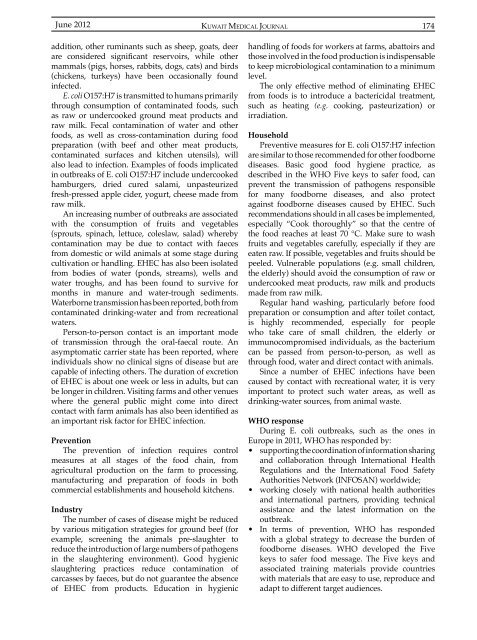Vol 44 # 2 June 2012 - Kma.org.kw
Vol 44 # 2 June 2012 - Kma.org.kw
Vol 44 # 2 June 2012 - Kma.org.kw
You also want an ePaper? Increase the reach of your titles
YUMPU automatically turns print PDFs into web optimized ePapers that Google loves.
<strong>June</strong> <strong>2012</strong><br />
KUWAIT MEDICAL JOURNAL 174<br />
addition, other ruminants such as sheep, goats, deer<br />
are considered significant reservoirs, while other<br />
mammals (pigs, horses, rabbits, dogs, cats) and birds<br />
(chickens, turkeys) have been occasionally found<br />
infected.<br />
E. coli O157:H7 is transmitted to humans primarily<br />
through consumption of contaminated foods, such<br />
as raw or undercooked ground meat products and<br />
raw milk. Fecal contamination of water and other<br />
foods, as well as cross-contamination during food<br />
preparation (with beef and other meat products,<br />
contaminated surfaces and kitchen utensils), will<br />
also lead to infection. Examples of foods implicated<br />
in outbreaks of E. coli O157:H7 include undercooked<br />
hamburgers, dried cured salami, unpasteurized<br />
fresh-pressed apple cider, yogurt, cheese made from<br />
raw milk.<br />
An increasing number of outbreaks are associated<br />
with the consumption of fruits and vegetables<br />
(sprouts, spinach, lettuce, coleslaw, salad) whereby<br />
contamination may be due to contact with faeces<br />
from domestic or wild animals at some stage during<br />
cultivation or handling. EHEC has also been isolated<br />
from bodies of water (ponds, streams), wells and<br />
water troughs, and has been found to survive for<br />
months in manure and water-trough sediments.<br />
Waterborne transmission has been reported, both from<br />
contaminated drinking-water and from recreational<br />
waters.<br />
Person-to-person contact is an important mode<br />
of transmission through the oral-faecal route. An<br />
asymptomatic carrier state has been reported, where<br />
individuals show no clinical signs of disease but are<br />
capable of infecting others. The duration of excretion<br />
of EHEC is about one week or less in adults, but can<br />
be longer in children. Visiting farms and other venues<br />
where the general public might come into direct<br />
contact with farm animals has also been identified as<br />
an important risk factor for EHEC infection.<br />
Prevention<br />
The prevention of infection requires control<br />
measures at all stages of the food chain, from<br />
agricultural production on the farm to processing,<br />
manufacturing and preparation of foods in both<br />
commercial establishments and household kitchens.<br />
Industry<br />
The number of cases of disease might be reduced<br />
by various mitigation strategies for ground beef (for<br />
example, screening the animals pre-slaughter to<br />
reduce the introduction of large numbers of pathogens<br />
in the slaughtering environment). Good hygienic<br />
slaughtering practices reduce contamination of<br />
carcasses by faeces, but do not guarantee the absence<br />
of EHEC from products. Education in hygienic<br />
handling of foods for workers at farms, abattoirs and<br />
those involved in the food production is indispensable<br />
to keep microbiological contamination to a minimum<br />
level.<br />
The only effective method of eliminating EHEC<br />
from foods is to introduce a bactericidal treatment,<br />
such as heating (e.g. cooking, pasteurization) or<br />
irradiation.<br />
Household<br />
Preventive measures for E. coli O157:H7 infection<br />
are similar to those recommended for other foodborne<br />
diseases. Basic good food hygiene practice, as<br />
described in the WHO Five keys to safer food, can<br />
prevent the transmission of pathogens responsible<br />
for many foodborne diseases, and also protect<br />
against foodborne diseases caused by EHEC. Such<br />
recommendations should in all cases be implemented,<br />
especially “Cook thoroughly” so that the centre of<br />
the food reaches at least 70 °C. Make sure to wash<br />
fruits and vegetables carefully, especially if they are<br />
eaten raw. If possible, vegetables and fruits should be<br />
peeled. Vulnerable populations (e.g. small children,<br />
the elderly) should avoid the consumption of raw or<br />
undercooked meat products, raw milk and products<br />
made from raw milk.<br />
Regular hand washing, particularly before food<br />
preparation or consumption and after toilet contact,<br />
is highly recommended, especially for people<br />
who take care of small children, the elderly or<br />
immunocompromised individuals, as the bacterium<br />
can be passed from person-to-person, as well as<br />
through food, water and direct contact with animals.<br />
Since a number of EHEC infections have been<br />
caused by contact with recreational water, it is very<br />
important to protect such water areas, as well as<br />
drinking-water sources, from animal waste.<br />
WHO response<br />
During E. coli outbreaks, such as the ones in<br />
Europe in 2011, WHO has responded by:<br />
• supporting the coordination of information sharing<br />
and collaboration through International Health<br />
Regulations and the International Food Safety<br />
Authorities Network (INFOSAN) worldwide;<br />
• working closely with national health authorities<br />
and international partners, providing technical<br />
assistance and the latest information on the<br />
outbreak.<br />
• In terms of prevention, WHO has responded<br />
with a global strategy to decrease the burden of<br />
foodborne diseases. WHO developed the Five<br />
keys to safer food message. The Five keys and<br />
associated training materials provide countries<br />
with materials that are easy to use, reproduce and<br />
adapt to different target audiences.
















